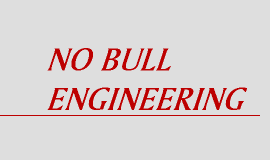TORSIONAL AND PULSATION DESIGN AUDITS
by
Mark A. Corbo, P.E.
President & Chief Engineer
No Bull Engineering
and
Stanley B. Malanoski
Engineering Consultant
No Bull Engineering
Originally presented at:
2007 Gas Machinery Conference
GMRC
Dallas, Texas
October 2007
The criticality of most gas processing machinery makes the performance of a rigorous design audit during the design phase almost mandatory. The cost of such an audit, although not insignificant, is at least an order of magnitude lower than the cost of dealing with most field problems that the audit is designed to prevent. Although the contents of the audit can vary, depending on the machinery and application, two staples of a good design audit are a torsional vibration analysis and an acoustic/pulsation analysis. The aim of this short course is, therefore, to educate users about these two highly critical subjects to the point where they understand the benefits accrued by performing these audits and have enough familiarity with them to intelligently review and critique the reports generated during this process. Although the information presented will be applicable to all types of machinery, the preponderance of reciprocating compressors in the gas processing arena will lead to a sharper focus on them.
The authors have previously published a comprehensive tutorial on torsional vibration entitled, “Practical Design Against Torsional Vibration,” at Texas A&M’s Turbomachinery Symposium in 1996. Although much of the material presented in this highly acclaimed paper (re-published by three other organizations) is applicable to the subject at hand, that work focused on rotary machinery, the primary interest of that particular audience. It is, therefore, the intent of the authors to build upon the material previously published by adding considerations that are important in reciprocating machinery, especially reciprocating compressors.
Likewise, the authors have also published a primer on pulsation analysis entitled, “Practical Design Against Pump Pulsations” at Texas A&M’s Pump Users Symposium in 2005. Although some of that material will be repeated herein, the focus will be shifted from liquid machines (i.e., pumps) to gas processing machines (i.e., compressors).
As would be expected, the short course is divided into two parts of approximately equal length – the first on torsional vibration and the second on pulsations. The torsional vibration portion begins with a description of what torsional vibration is, and the destructive effects it can have, such as broken shafts, failed couplings, and auxiliary component failures, if not properly designed for, especially in reciprocating machines. Basic concepts such as natural frequencies, mode shapes, and resonance are described. Guidelines for generating torsional models, with a particular focus on dealing with non-axisymmetric shafts (i.e., crankshafts) and reciprocating parts, are then provided. Methods for calculating natural frequencies are then discussed. However, this area is intentionally limited in scope since it is our experience that most users encounter little difficulty in determining their machine’s natural frequencies due to the large number of resources available in that area. The problems often arise at the next step - when they must translate this information into an accurate prediction of whether or not their design will experience any torsional vibration problems in the field. Accordingly, greater focus is provided on the steps that should be taken once the natural frequencies are found.
The generation of an interference or Campbell diagram, and the determination of potential resonance points, is then treated in far more detail. Of particular interest is generation of the upward sloping lines representing the system’s excitation frequencies. The various excitation sources commonly found in reciprocating and rotating machinery, such as reciprocating compressors and engines, gears, vaned impellers, and electric motors, are discussed along with the excitation frequencies that each introduces into the system. The unique problems associated with the startup of systems driven by synchronous motors are also briefly described.
The next step in the audit, performance of the forced response analysis, is then described in detail. Since, in direct contrast to rotating machinery, torsional problems can occur in reciprocating trains even in the absence of resonance, a steady-state response analysis must always be performed for such trains. Since there are also cases, such as when loaded shutdowns can occur, where transient response analyses are also needed, these analyses are also briefly described.
Methods for determining the magnitudes and locations of excitation torques for various machinery classes are given. In keeping with this course’s focus, the particulars of reciprocating machine excitations, such as gas pressure excitations, inertia excitations, Fourier coefficients, and the effects of cylinder misfire, compressor valve failure, and compressor pockets and unloaders, are described in detail. Procedures are provided for obtaining damping coefficients for typical sources such as shaft material hysteresis, fluid-film bearings in geared systems, and couplings. The criticality of analyzing all potential reciprocating compressor operating conditions (load steps, pressures, flows, gas compositions, etc.) is emphasized. Finally, users are provided with ground rules for utilizing the calculated cyclic torques and stresses, as well as amplitudes at auxiliary ends, to determine their design’s adequacy.
If the audit identifies problem areas, practical and relatively simple rectification methods are provided. In some cases, the change of a compressor cylinder loading sequence, relative phasing of engine and compressor excitations, or an engine firing order is sufficient. However, since in other cases, the addition of a flywheel, torsional vibration damper, or damper coupling to the system is required, some of the more common types are described.
At the conclusion of the torsional portion, a complete step-by-step analysis procedure is given which summarizes the entire preceding discussion. This methodology can be utilized in the design of virtually any gas processing system the reader may encounter. Finally, a checklist of items that should be included in any torsional design audit is provided to help the user evaluate the usefulness of audits performed on their equipment.
The pulsation portion of the short course commences with a description of what pulsation is and the types of problems it can cause in users’ piping systems and compressor manifolds. In cases where a fluid excitation is coincident with both an acoustic resonance and a mechanical resonance of the piping system, large piping vibrations, noise, and failures of pipes and attachments can occur. Other problems that uncontrolled pulsations can generate include valve failures and degradation of performance. The potential for problems greatly increases in multiple compressor installations due to the higher energy levels, interaction between compressors, and more complex piping systems involved.
The aim of this portion of the short course is to provide users with a basic understanding of pulsations, which are simply pressure disturbances that travel through the fluid in a piping system at the speed of sound, their potential for generating problems, and acoustic analysis and, also, to provide tips for prevention of field problems.
Accordingly, this portion of the course begins with a discussion of pulsations and why they are important in gas processing systems. Since pulsation problems are almost always associated with the resonant excitation of acoustic natural frequencies, the fundamental concepts of acoustic natural frequencies, mode shapes, acoustic impedance, and resonance are described. For the many users who are familiar with mechanical systems, an analogy with mechanical natural frequencies is drawn and the basic acoustic elements of compliance, inertia, and resistance are compared to their mechanical equivalents (springs, masses, and dampers, respectively). Natural frequency equations and mode shapes are then given for the simplest piping systems, the quarter-wave stub and half-wave element. The dependence of acoustic natural frequencies on piping diameters, lengths, end conditions, and the local acoustic velocity (which, itself, is dependent on many parameters) is also discussed.
The most common pulsation excitation sources in compression systems are then described in detail. The first and probably best-known is the compression elements, particularly those of reciprocating compressors. Although reciprocating compressors, and their characteristic pulsatile flows, are deservedly infamous in this area, pulsations can also occur in centrifugal compressors, especially when running at off-design conditions and possessing positively-sloped head-flow characteristics. Second, excitations can arise due to vortex shedding arising at piping discontinuities such as tees and valves.
The procedure for performing a thorough acoustic design audit is then described in detail. Elements that must be considered in a good acoustic model are discussed and the methods for modeling such elements, such as piping, manifolds, excitation sources, valves, and pulsation control devices are described in detail. The three major types of analysis, natural frequency, steady-state response, and time transient response are then discussed in detail. The criticality of analyzing all potential reciprocating compressor operating conditions (load steps, pressures, flows, gas compositions, etc.) is once again emphasized. Finally, users are provided with ground rules for utilizing the calculated acoustic natural frequencies, pressure pulsation amplitudes, and piping force amplitudes, to determine their design’s adequacy.
The short course then addresses the various pulsation control elements that are available and methods for sizing them and locating them within the system. Elements discussed in detail include surge volumes, bottles, acoustic filters (networks of acoustic volumes and resistance elements), and dissipative elements such as orifices. The advantages and disadvantages of each type, including the frequency ranges over which each are most effective, are discussed in detail. Emphasis is placed on proper location of these elements since a perfectly-sized element placed at the wrong point in the system can actually do more harm than good.
The short course concludes with a discussion of the elements that make up a good acoustic analysis computer code. Several examples of acoustic analyses that the authors have recently performed are also provided. Finally, a checklist of elements that should be included in a good pulsation audit is presented for the benefit of users.
ORDER YOUR FREE COPY
BACK
| Home | Why Hire Us? | Services | Principals & Staff | Clients |
| Technical Papers | Short Courses | News Items | Contact Us |

